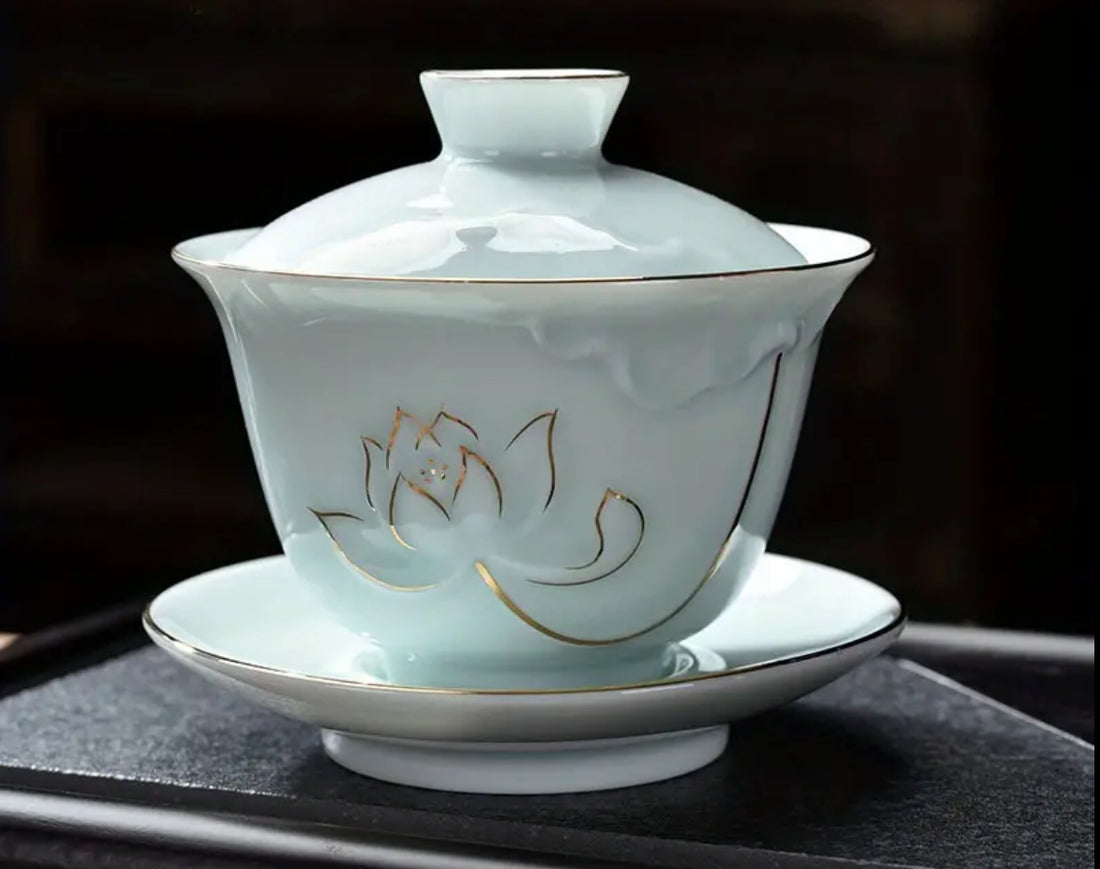
Gaiwan in Tea Culture
Share
The gaiwan plays a central role in Chinese tea culture, particularly in the context of traditional tea ceremonies such as gongfu cha (工夫茶). Its use reflects not only the practical aspects of brewing tea but also deeper cultural, spiritual, and aesthetic values. The gaiwan has been a key vessel in tea culture for centuries, influencing the art of tea preparation and enhancing the experience of tea tasting. Here’s how the gaiwan fits into Chinese tea culture:
Symbol of Simplicity and Elegance:
The design of the gaiwan embodies simplicity and refinement, which aligns with traditional Chinese aesthetics. Its clean lines, minimalistic form, and practical structure reflect the Daoist philosophy of finding beauty in simplicity and function.
The practice of using a gaiwan encourages mindfulness, as it requires the user to be fully present, from selecting the tea leaves to handling the lid and controlling the pour.

Importance in Gongfu Cha:
In gongfu cha, a traditional Chinese tea ceremony that emphasizes skillful and careful tea brewing, the gaiwan is often the preferred brewing vessel. The ceremony is focused on extracting the best flavor from tea leaves through multiple short infusions, and the gaiwan allows the tea master to control the temperature, infusion time, and water-to-tea ratio with great precision.
Gongfu cha is not only about tea preparation but also about creating a meditative and social environment. The handling of the gaiwan—using both hands to control the lid and the bowl—is an essential part of the ritual, symbolizing harmony and balance.
Versatility in Tea Brewing:
The gaiwan is used to brew a wide variety of teas, including green tea, white tea, oolong tea, yellow tea, black tea, and puerh tea. Its open design allows tea leaves to expand fully and release their flavors gradually over multiple infusions, a practice that is at the heart of Chinese tea appreciation.
In tea culture, brewing with a gaiwan is seen as a way to extract the essence and spirit of the tea, particularly when tasting high-quality teas that develop in complexity across several infusions.

Enhancing the Sensory Experience:
The wide shape of the gaiwan allows the drinker to appreciate the aroma of the tea before tasting it. Smelling the tea’s fragrance after lifting the lid is an important part of the tea-tasting experience, helping to build anticipation and enhancing appreciation.
Gaiwan use is about engaging all senses: sight (the color of the tea), smell (the aroma), taste (the flavor), touch (the warmth of the vessel), and even sound (the pouring of water).
Symbol of Hospitality and Social Bonding:
In traditional Chinese culture, serving tea with a gaiwan is a symbol of hospitality and respect. Guests are often offered tea brewed in a gaiwan as part of formal and informal gatherings.
The gaiwan encourages interaction and conversation, as the brewing and serving process is done openly, often involving guests in the appreciation of the tea. It reflects a philosophy of sharing and community.

Preservation of Cultural Heritage:
The gaiwan is an important part of tea culture preservation in China. In modern times, while many people use teapots or modern brewing methods, the gaiwan remains a symbol of the traditional way of life, connecting tea drinkers to ancient customs and rituals.
Many tea houses in China and around the world continue to use gaiwans as a way to educate and immerse people in Chinese tea traditions.

Spiritual and Philosophical Connections:
The careful handling of a gaiwan in tea preparation can be a meditative practice, especially when done slowly and mindfully. The attention required to balance the lid, the bowl, and the pour mirrors the philosophies of Daoism and Buddhism, which value balance, harmony, and presence.
Drinking tea from a gaiwan is often seen as a way to cultivate inner peace and clarity, with some rituals even likened to forms of moving meditation.
Aesthetic and Ceremonial Significance:
The gaiwan has long been part of Chinese tea aesthetics. It is used in ceremonial contexts not only for its functionality but also for its role as a beautiful object. The materials used (porcelain, clay, glass) and the often intricate designs and patterns on gaiwans reflect traditional Chinese art and craftsmanship.
The aesthetic significance of the gaiwan goes beyond its design to include the grace and skill of the person using it. The movements involved in brewing tea with a gaiwan are considered an art form, much like calligraphy or flower arranging.
Accessibility to Tea Connoisseurs and Beginners:
While using a gaiwan may seem daunting at first due to the required technique in handling the hot bowl and lid, it is widely considered one of the best vessels for learning about tea. Beginners and tea experts alike use it because it allows for a more direct connection with the tea leaves during the brewing process.
The gaiwan provides a transparent and hands-on way to understand the characteristics of different teas, from observing the leaf expansion to controlling the strength of each brew.
____________________
The gaiwan is more than just a functional tool for brewing tea; it is a vessel imbued with centuries of cultural significance, philosophical meaning, and artistic value. Its use in tea culture reflects a deep respect for the art of tea making, promoting mindfulness, connection, and an appreciation of life’s simple pleasures. Whether used in formal ceremonies or everyday tea drinking, the gaiwan continues to be a symbol of elegance, tradition, and the timeless nature of Chinese tea culture.

1 comment
I read that a Taiwan also represents heaven/life, human/cup and saucer/earth. Is this true?